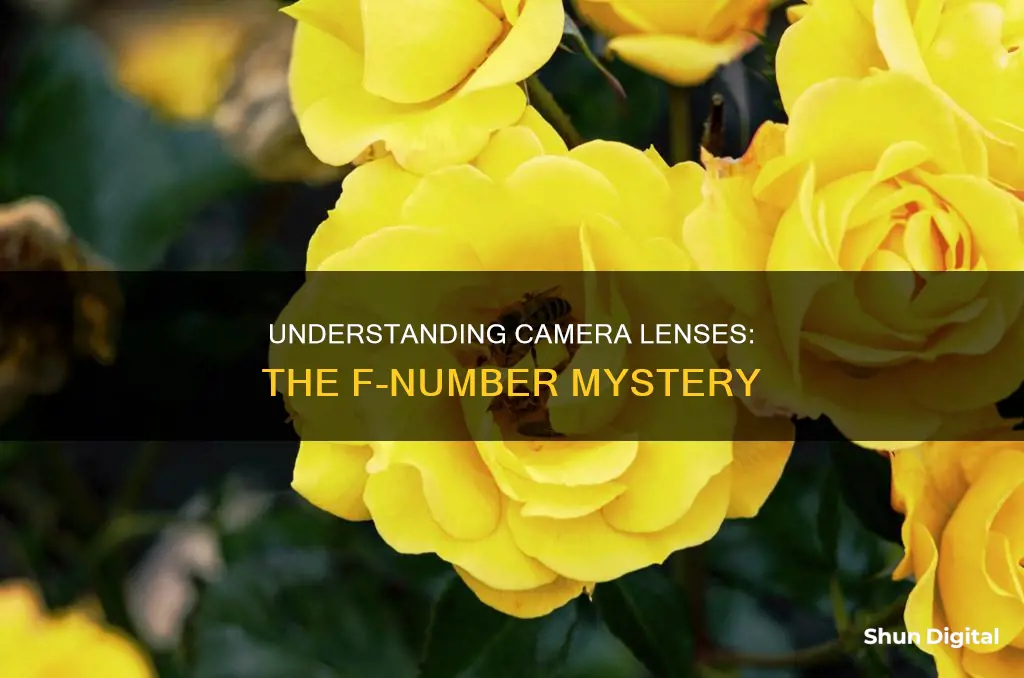
The f-number of a camera lens is a measure of its light-gathering ability. It is calculated by dividing the lens's focal length by the diameter of the entrance pupil. The f-number is also known as the focal ratio, f-ratio, or f-stop. A lower f-number means a larger aperture and more light entering the lens, while a higher f-number means a smaller aperture and less light entering the lens. The f-number is key in determining the depth of field, diffraction, and exposure of a photograph.
| Characteristics | Values |
|---|---|
| Definition | A measure of the light-gathering ability of an optical system such as a camera lens |
| Calculation | Focal length divided by the diameter of the entrance pupil |
| Other names | Focal ratio, f-ratio, f-stop, inverse relative aperture |
| Expression | Dimensionless, usually expressed as f/N, where N is the f-number |
| Aperture and f-stop | The "f" in f-stop stands for the focal length of the lens |
| Aperture and focal length | The focal length is the number that describes if the lens is a wide-angle lens or a telephoto lens |
| Aperture and depth of field | A large aperture results in a large amount of foreground and background blur; a small aperture results in a wide depth of field |
| Aperture and exposure | A large aperture (a wide opening) will pass a lot of light, resulting in a brighter photograph |
What You'll Learn

F-number is the ratio of the lens focal length to the diameter of the entrance pupil
The F-number, also known as the f-stop or focal ratio, is a measure of the light-gathering ability of a camera lens. It is calculated by dividing the lens focal length by the diameter of the entrance pupil (or "clear aperture"). The F-number is a crucial concept in photography, as it determines the depth of field, diffraction, and exposure of a photograph.
The F-number is expressed as a fraction, with "f" as the numerator and the F-number as the denominator. For example, an F-number of f/2 represents a larger aperture than f/16. A lower F-number means a larger aperture and more light entering the camera, resulting in a brighter photograph. Conversely, a higher F-number indicates a smaller aperture, allowing less light to enter, and producing a darker image.
The F-number is calculated using the formula: N = f/D, where N is the F-number, f is the focal length, and D is the diameter of the entrance pupil. For instance, if a lens has a focal length of 100mm and an entrance pupil diameter of 50mm, the F-number would be 2, denoted as f/2.
Understanding the F-number is essential for photographers to capture stunning images. It allows them to adjust the aperture, which is the opening in the lens that controls the amount of light entering the camera. By manipulating the F-number, photographers can achieve the desired brightness and depth of field for their photographs.
The F-number is also crucial in determining the relative aperture, which indicates how much light can pass through the lens at a given focal length. A lower F-number corresponds to a larger relative aperture, allowing more light to enter the system. Conversely, a higher F-number results in a smaller relative aperture and reduced light transmission.
Understanding Camera Lenses: A Beginner's Guide to Photography
You may want to see also

F-number is written as a fraction, with f as the numerator
F-number, also known as f-stop, is the ratio of the lens focal length to the diameter of the entrance pupil. It is written as a fraction, with "f" as the numerator and the f-stop number as the denominator. For example, an f-number of f/2 means that the focal length of the lens is twice the diameter of the entrance pupil.
The f-number is a measure of the light-gathering ability of a camera lens. A lower f-number means a larger aperture and more light entering the system, resulting in a brighter photograph. Conversely, a higher f-number means a smaller aperture and less light entering the system, leading to a darker image.
The f-number is usually expressed using a lower-case hooked f with the format f/N, where N is the f-number. For instance, if a lens has a focal length of 100mm and an entrance pupil diameter of 50mm, the f-number would be 2, written as f/2.
The aperture size is inversely related to the f-number. A smaller f-number indicates a larger aperture, while a larger f-number corresponds to a smaller aperture. For example, an aperture of f/2 is much larger than an aperture of f/16.
The f-number plays a crucial role in determining the depth of field, exposure, and diffraction of a photograph. It is one of the fundamental components of the exposure triangle in photography, along with shutter speed and ISO (light sensitivity).
By adjusting the f-stop, photographers can control the amount of light entering the camera and the depth of field in their images. A lower f-number creates a shallow depth of field, resulting in a blurred background, while a higher f-number increases the depth of field, keeping both the foreground and background in focus.
The Magic of Fikters for Your Camera Lenses
You may want to see also

F-number determines the depth of field
F-number, also known as focal ratio, f-ratio, or f-stop, is a measure of the light-gathering ability of a camera lens. It is calculated by dividing the system's focal length by the diameter of the entrance pupil (or "clear aperture"). The f-number is expressed as a fraction, with "f" as the numerator and the f-stop number as the denominator.
F-number plays a crucial role in determining the depth of field (DOF) in photography. DOF refers to the zone within a photo that appears acceptably sharp and in focus. It is the distance between the nearest and farthest objects that are in acceptably sharp focus in an image. By adjusting the f-number, photographers can control the depth of field in their images.
A lower f-number means a larger aperture, allowing more light to enter the camera system and resulting in a shallower depth of field. This is often used in portrait photography to blur the background and bring attention to the subject. On the other hand, a higher f-number means a smaller aperture and less light entering the system, creating a deeper depth of field. Landscape photographers often use higher f-numbers to ensure that both the foreground and background elements are in focus.
The relationship between f-number and depth of field is not the only factor that affects DOF. The distance between the camera and the subject also plays a significant role. As the camera moves closer to the subject, the depth of field decreases, resulting in a shallower focus. Additionally, the focal length of the lens comes into play. Longer focal lengths produce shallower depth of field effects, while shorter focal lengths result in deeper depth of field.
Understanding the impact of f-number on depth of field is essential for photographers to master their craft. By manipulating the f-number, along with other variables such as distance and focal length, photographers can creatively control the focus and artistic impact of their images.
Camera Lenses: The Ultimate Must-Have List for Photographers
You may want to see also

A lower f-number means a larger relative aperture
The "f" in f-number stands for "focal length". The f-number is a ratio of the lens focal length to the diameter of the entrance pupil. In other words, the f-number is the focal length divided by the aperture diameter.
The f-number is also known as the inverse relative aperture. This is because it is the inverse of the relative aperture, which is the aperture diameter divided by the focal length.
The f-number is a measure of the light-gathering ability of an optical system such as a camera lens. It is key in determining the depth of field, diffraction, and exposure of a photograph.
The f-number is usually expressed using a lower-case hooked f with the format f/N, where N is the f-number. For example, f/2.8 or f/16.
A larger aperture lets in a lot of light, which is useful for low-light scenarios. It is also commonly used in portrait photography to make the subject stand out while softening the background.
EF-S Lenses: Full-Frame Camera Compatibility Explored
You may want to see also

A higher f-number means a smaller relative aperture
The f-number of a camera lens is a measure of the lens's light-gathering ability. It is calculated by dividing the system's focal length by the diameter of the entrance pupil (or "clear aperture"). The f-number is also known as the focal ratio, f-ratio, or f-stop, and it is key in determining the depth of field, diffraction, and exposure of a photograph.
The f-number is also known as the inverse relative aperture. This is because it is the inverse of the relative aperture, which is defined as the aperture diameter divided by the focal length. The relative aperture indicates how much light can pass through the lens at a given focal length.
A lower f-number means a larger relative aperture, which lets more light enter the system. Conversely, a higher f-number means a smaller relative aperture and less light entering the system.
The f-number can be useful in various photography scenarios. For example, in portrait photography, a lower f-number is often used to create a shallow depth of field, blurring the background and bringing the viewer's focus to the subject. In landscape photography, a higher f-number is typically used to ensure that both the foreground and background are in focus.
In addition to the amount of light that passes through, the f-number also affects the depth of field – how much of the image appears to be in focus. A higher f-number results in a larger depth of field, while a lower f-number creates a shallow depth of field.
The f-number setting is an important consideration in photography, as it directly impacts the brightness and depth of field of a photograph. It is one of the three fundamental components that make up the exposure triangle in photography, along with shutter speed and ISO (sensitivity to light).
By understanding the relationship between f-number and relative aperture, photographers can effectively control the amount of light entering the camera and achieve the desired depth of field for their images.
Projector Lenses: Can They Double as Cameras?
You may want to see also
Frequently asked questions
The f-number, also known as the f-stop, is a measure of the light-gathering ability of a camera lens. It is calculated by dividing the lens's focal length by the diameter of the entrance pupil.
The "f" in f-number stands for "focal length".
A lower f-number means a larger aperture, which lets in more light, resulting in a brighter photograph. A higher f-number means a smaller aperture, letting in less light and making the photo darker.
A lower f-number, or larger aperture, results in a shallow depth of field, with the background appearing blurry. A higher f-number, or smaller aperture, gives a wider depth of field, keeping both the foreground and background in focus.
The maximum aperture, or "wide-open" aperture, is the largest opening the lens can achieve, letting in the most light. The minimum aperture is the smallest opening, letting in the least amount of light.







